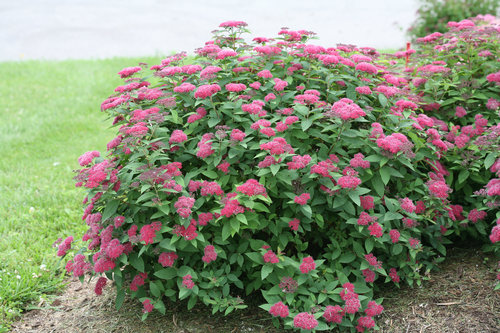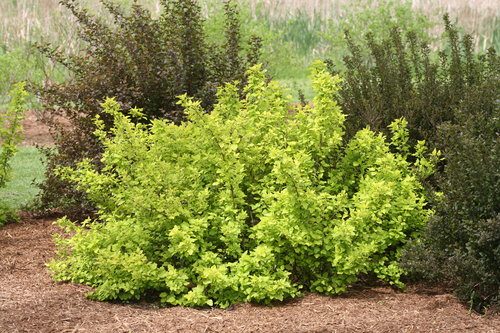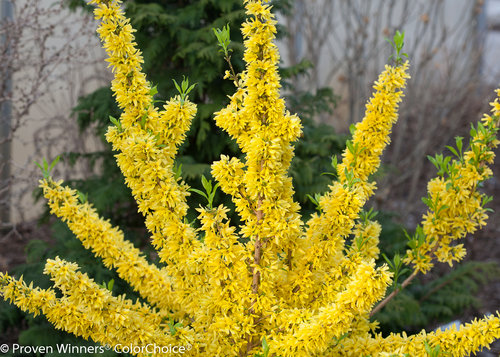Fertilizing Trees & Shrubs
Essential elements for plant nutrition include nitrogen, phosphorus, potassium, calcium, zinc, copper, molybdenum, magnesium, iron, sulfur, manganese and boron. They come from the soil and from applied fertilizer. Plants obtain carbon, hydrogen and oxygen from the air or through the soil.
Nutrient Needs of Shrubs
Essential elements for plant nutrition include nitrogen, phosphorus, potassium, calcium, zinc, copper, molybdenum, magnesium, iron, sulfur, manganese and boron. They come
from the soil and from applied fertilizer. Plants obtain carbon, hydrogen and oxygen from the air or through the soil.
Certain elements--such as boron, zinc, manganese, iron, copper and molybdenum--are called micronutrients, because plants require very small amounts of them. However, they are just as essential for plant growth as the macronutrients - nitrogen, phosphorus and potassium--which are required in larger amounts.
Objectives Of Fertilizer Application 
Fertilizers may help improve the appearance and condition of ornamental trees and shrubs. Increased vigor may make the plants more resistant to attack by disease organisms and insects.
Many factors influence the fertilization program of plants in the landscape. Unlike similar plants growing in the nursery, landscape plants are often growing under stress. Fertilization practices leading to satisfactory plant growth must take into account these stresses.
Fertilizer response varies with the plant and the environment. Soil fertility, aeration, drainage, exposure to sun and wind, temperature of the site, and proximity to buildings, walks and streets are but a few of the many factors that influence plant growth.
Analysis or Fertilizer Grade
The analysis or grade refers to the minimum amounts of N, P2O5 and K20 in the fertilizer. A 10-10-10 fertilizer would contain 10 percent nitrogen (N), 10 percent P2O5
equivalent and 10 percent K2O equivalent. In 50 pounds of 10-10-10, there are 5 pounds of N, 5 pounds of P2O5 equivalent and 5 pounds of K2O equivalent.
In the future, fertilizers will most likely be expressed entirely in the elemental form--N-P-K--rather than the N-P2O5-K2O used today. Then today's conventional 10-10-10 fertilizer will be a 10-4-8 fertilizer. The percentage of P in P2O5 is 43.6, so multiplying the pounds of P2O5 by .436, gives the pounds of actual P in a fertilizer. The
percentage of K in K2O is 83, so multiplying the pounds of K2O by .83 gives the actual K in a bag of fertilizer.
If any of these elements are not present in the formulation, a zero would appear in the analysis. For example, ammonium nitrate has no phosphorus or potassium, and its analysis is 33-0-0.
To compute the number of pounds of nitrogen in a 100 pounds bag of ammonium nitrate (NH4NO3) multiply 100 x .33, which equals 33 pounds of nitrogen. Dividing 33 by the unit cost yields cost per pound of nitrogen.
Organic and Inorganic Sources
Fertilizers may be divided into two broad groups: organic and inorganic, or chemical. An organic fertilizer is derived from a living plant or animal source. Nitrogen
in an organic fertilizer is slow in becoming available for plant use because the organic nitrogen (NH2) must be reduced by micro-organisms to ammonium (NH4) or nitrate
(NO3). Generally, home gardeners tend to use organic fertilizers more than commercial producers do because of their high cost per pound of actual nutrient element. Urea however, a synthetic organic fertilizer that is 45 percent N, is available at a low cost. In moist media at a temperature above 60 degree F., it takes only about three to five days for the complete conversion of urea to ammonium.
Another organic fertilizer that may soon be used in greater quantities is sewage sludge. Plants have been shown to respond favorably when sewage sludge was applied to the soil. Further research is needed before specific recommendations will be made.
Chemical fertilizers are either mixed or manufactured and have the advantage of low cost. Consequently, most fertilizers used today are from chemical sources. High analysis, water soluble, chemical fertilizers will injury plants if not washed or brushed off the foliage. 
Slow Release Fertilizers
Slow release fertilizers may be either inorganic or organic. They are characterized by a slow rate of release, long residual, low burn potential, low water solubility and they cost more than water soluble fertilizer.
The most common element in a slow release fertilizer is nitrogen. Several categories of slow release nitrogen fertilizers are commercially available, including: --Ureaformaldehyde (UF) (38-0-0). Released by microbial degradation. --Isobutylidene diurea (IBDU) (31-0-0). Released by soil moisture and particle size. --Sulfur coated urea (SCU) (36-0-0).Release rate controlled by coating thickness. --Plastic coated fertilizers (various formulations). Release dependent on temperature and coating thickness. --Natural organics--sewage sludge, process tankage and fish scrap.
Unlike most granular inorganic fertilizers, which contain water soluble nitrogen (WSN), these slow release fertilizers are primarily composed of water insoluble nitrogen (WIN), which is released slowly. The majority of the slow release fertilizers offer both rapid initial release and long term release of nitrogen.
Liquid Fertilizers
Soluble fertilizers have gained importance over the years in landscape management and nursery production. They are widely used to prevent and correct minor nutrient
deficiencies. Soluble fertilizers are applied either on the foliage or on the soil.
Liquid fertilizers are important in production of nursery stock, particularly as additives in spray operations. Landscape and grounds personnel use liquid fertilizers extensively for deep root feeding of trees and shrubs.
Fertilizer Rates
The purpose of fertilizing landscape plants during the first year or two after transplanting is to increase height, width and caliper. Once the plants are
established and growing well, however, the function of fertilizing is to continue satisfactory growth and health but not necessarily to produce maximum height or caliper.
 |  |  |
After Planting
Research has shown that about 3 lbs. of actual nitrogen, the element most responsible for vegetative growth, per 1,000 square feet per year is all that is needed to maintain the health of woody plants in most landscape situations. If foliage color, annual growth or general vigor is not normal, collect foliar samples, have them analyzed and follow the recommendations that come back with the results. Otherwise, use the suggested rate as a guide.
To calculate the surface area under the branch spread of a tree, multiply the radius times itself and then multiply that by 3.14 (surface area = Radius2 x 3.14). (The radius is the distance from the trunk to the edge of the branch spread.) As an example, a 6-inch diameter trunk with a total branch spread of 36 feet would have a radius of 18 feet. The area, according to the formula would equal 18 x 18 x 3.14, or 1,017 square feet. Following the recommendation of 3 lbs. of actual nitrogen per 1,000 square feet, you would apply about 9 lbs. of 33-0-0 fertilizer (3 divided by .33 = 9 lbs.).
Woody plants respond well to fertilizers with a 3-1-2 or 3-1-1 ratio, such as 24-8-16, 18-6-12, 18-5-9, 15-5-5, 12-4-4 or similar formulations. An application of 3 lbs. of actual nitrogen per 1,000 sq. ft. applies 1 lb. of P2O5 and 2 lbs. of K2O when using a 3-1-2 ratio.
The trend in recent years has been for fertilizer formulators to use higher analyses in the fertilizer package. Often the nitrogen content is 30 percent or more
and four or five times the phosphorus level. These formulations, though promoted for turf, can be satisfactorily used around woody plants. In fact, plants with root zones beneath lawn areas that are fertilized at least three times per year do not need additional fertilizer applications. The use of fertilizer and herbicide combinations around landscape ornamentals increases the chance of herbicide injury on the ornamentals.
Timing Fertilizer Applications
In the landscape, plants are fertilized in spring and fall. Fertilizing twice a year is preferable to the common practice of fertilizing every two to three years.
The best time to fertilize is fall, generally after the first hard freeze in September or October. The next best time would be before growth begins in early spring, usually between March and early May. If fertilizer is not applied in the fall or the spring, it may be applied up to July 1. Fertilizer applied after July 1 could promote a late flush of growth that may not have time to mature before freezing temperatures occur in the fall. 
Methods Of Fertilizer Application
The various methods of fertilizer application include injecting liquids into the soil, placing dry fertilizer in holes drilled in the soil, applying fertilizer to the soil surface and spraying it on the foliage. Which method you choose should depend on the site and plant condition.
With most woody plant species, surface application is as effective in provoking a positive plant response as other
methods. This method requires the least application time and is the least expensive.
Liquid fertilizer injected into the soil is rapidly taken into the plant by the roots, so injection is a good way to apply necessary nutrients. Also, the addition of water to dry soil is desirable during periods of drought. Injection sites should be 2 to 3 feet apart, depending on the injection pressure and 15 to 18 inches deep for established trees.
A major advantage to the drill hole method is the opening of heavy (clay) or compacted soils, which allows air and fertilizer to penetrate. With this technique and liquid injection you avoid the excess grass growth that surface applications cause in turf areas.
The drill holes should be placed in concentric circles in the soil around the plant, beginning 3 feet from the main stem and extending 3 feet beyond the dripline. Space holes 2 feet apart and drill them 15 to 18 inches deep. The recommended rate of fertilizer should be uniformly distributed among the holes. Fill small holes with sand following fertilization but only partially fill large holes.
Liquid fertilizer sprayed on the foliage can not provide all the necessary nutrients required by plants in the amounts needed for satisfactory growth, but it can be very effective for correcting minor nutrient deficiencies, especially for treating iron deficiency using chelated iron.
Micronutrient spray applications are most effective when made just before or during a period of active growth, usually from spring to early summer. Plant responses include greening of chlorotic foliage and normal growth coming from buds on affected shoots. These effects are usually observed from two to eight weeks after treatment, but response time varies, depending on species, age of the plant and its parts, the time of year, the severity of the deficiency and the soil conditions under which the plants are growing.
One or two applications during the year will prevent or control deficiencies, but under some conditions it may be necessary to make several treatments annually to continue healthy growth. Using annual foliar sprays to correct a chronic nutrient deficiency is usually not a practical management practice for large trees.





